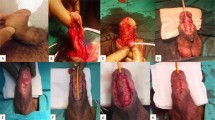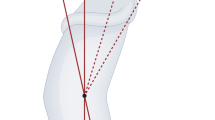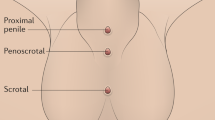Abstract
Hypospadias is a common condition and familiar, though sometimes challenging territory for the pediatric urologist. This review is a summary of hypospadias incidence, epidemiology, surgery, research, and complications intended for the non-specialist. It outlines the history, the principles of surgery for hypospadias, and the long-term outcomes.
This is a preview of subscription content, access via your institution
Access options
Subscribe to this journal
Receive 8 print issues and online access
$259.00 per year
only $32.38 per issue
Buy this article
- Purchase on Springer Link
- Instant access to full article PDF
Prices may be subject to local taxes which are calculated during checkout

Similar content being viewed by others
References
Springer A, van den Heijkant M, Baumann S. Worldwide prevalence of hypospadias. J Pediatr Urol. 2016;12:152.e1–7. https://doi.org/10.1016/j.jpurol.2015.12.002.
Bergman JE, Laone M, Vrijeid M, Pierini A, Nijman RJ, Addor MC, et al. Epidemiology of hypospadias in Europe: a registry-based study. World J Urol. 2015;33:2159–67. https://doi.org/10.1007/s00345-015-1507-6.
van der Zanden LF, van Rooij IA, Feitz WF, Franke B, Knoers NV, Roeleveld N, et al. Aetiology of hypospadias: a systematic review of genes and environment. Hum Reprod Update. 2012;18:260–83. https://doi.org/10.1093/humupd/dms002.
Ea V, Bergounoux A, Philbert P, Servat-Fauconnet N, Faure A, Breaud J, et al. How far should we explore hypospadias? Next-generation sequencing applied to a large cohort of hypospadiac patients. Eur Urol. 2021;79:507–15. https://doi.org/10.1016/j.eururo.2020.12.036.
Hsieh MH, Breyer BN, Eisenberg ML, Baskin LS. Associations among hypospadias, cryptorchidism, anogenital distance, and endocrine disruption. Curr Urol Rep. 2008;9:137–42. https://doi.org/10.1007/s11934-008-0025-0.
Matsushita S, Suzuki K, Murashima A, Kajioka D, Acebedo AR, Miyagawa S, et al. Regulation of masculinization: androgen signalling for external genitalia development. Nat Rev Urol. 2018;15:358–68. https://doi.org/10.1038/s41585-018-0008-y.
Carmack A, Notini L, Earp BD. Should surgery for hypospadias be performed before an age of consent? J Sex Res. 2016;53:1047–58. https://doi.org/10.1080/00224499.2015.1066745.
De Win G, Hoebeke P, Wood D, Cuckow P. Long-term outcomes of pediatric hypospadias and surgical intervention. Pediatr Health Med Ther. 2012;3:69–77.
van der Horst HJ, de Wall LL. Hypospadias, all there is to know. Eur J Pediatr. 2017;176:435–41. https://doi.org/10.1007/s00431-017-2864-5.
Manzoni G, Bracka A, Palminteri E, Marrocco G. Hypospadias surgery: when, what and by whom? BJU Int. 2004;94:1188–95. https://doi.org/10.1046/j.1464-410x.2004.05128.x.
Hadidi AT. History of hypospadias: Lost in translation. J Pediatr Surg. 2017;52:211–7. https://doi.org/10.1016/j.jpedsurg.2016.11.004.
Lambert SM, Snyder HM 3rd, Canning DA. The history of hypospadias and hypospadias repairs. Urology. 2011;77:1277–83. https://doi.org/10.1016/j.urology.2010.10.031.
Halstead NV, MP, Wilcox DT. In: Essentials of pediatric urology. Thomas DFM, Wilcox DT, editors. Ch. 16, CRC Press; Florida, USA. 2022. p. 209–26.
Springer A, Krois W, Horcher E. Trends in hypospadias surgery: results of a worldwide survey. Eur Urol. 2011;60:1184–9. https://doi.org/10.1016/j.eururo.2011.08.031.
Snodgrass WT. Snodgrass technique for hypospadias repair. BJU Int. 2005;95:683–93. https://doi.org/10.1111/j.1464-410X.2005.05384.x.
Snodgrass WT. Tubularized incised plate hypospadias repair: indications, technique, and complications. Urology. 1999;54:6–11. https://doi.org/10.1016/s0090-4295(99)00144-2.
Johal NS, Nitkunan T, O’Malley K, Cuckow PM. The two-stage repair for severe primary hypospadias. Eur Urol. 2006;50:366–71. https://doi.org/10.1016/j.eururo.2006.01.002.
Halstead NV, Mouriquand PDE, Wilcox DT. In: Essentials of pediatric urology. Wilcox DT, Thomas DFM, editors. Ch. 16, Routledge, CRC Press, Florida, USA. 2021.
Perovic S, Vukadinovic V. Penoscrotal transposition with hypospadias: 1-stage repair. J Urol. 1992;148:1510–3. https://doi.org/10.1016/s0022-5347(17)36952-5.
Pinke LA, Rathbun SR, Husmann DA, Kramer SA. Penoscrotal transposition: review of 53 patients. J Urol. 2001;166:1865–8. https://doi.org/10.1016/s0022-5347(05)65708-4.
Schoenwolf GC, Bleyl SB, Brauer PR, Francis-West PH. In: Larsen’s human embryology. Churchill Livingstone/Elsevier; Philadelphia, USA 2009.
Baskin L, Derpinghaus A, Cao M, Sinclair A, Li Y, Overland M, et al. Hot spots in fetal human penile and clitoral development. Differentiation. 2020;112:27–38. https://doi.org/10.1016/j.diff.2019.11.001.
Snodgrass W, Macedo A, Hoebeke P, Mouriquand PD. Hypospadias dilemmas: a round table. J Pediatr Urol. 2011;7:145–57. https://doi.org/10.1016/j.jpurol.2010.11.009.
Hadidi AT, Roessler J, Coerdt W. Development of the human male urethra: a histochemical study on human embryos. J Pediatr Surg. 2014;49:1146–52. https://doi.org/10.1016/j.jpedsurg.2014.01.009.
Baskin L, Shen J, Sinclair A, Cao M, Liu X, Liu G, et al. Development of the human penis and clitoris. Differentiation. 2018;103:74–85. https://doi.org/10.1016/j.diff.2018.08.001.
Van Batavia JP, Canning DA, Zaontz MR. In: Consent in pediatric urology. Godbole P, Wilcox DT, Koyle MA, editors. Springer Link; Switzerland. 2016.
Vavilov S, Smith G, Starkey M, Pockney P, Deshpande AV. Parental decision regret in childhood hypospadias surgery: a systematic review. J Paediatr Child Health. 2020;56:1514–20. https://doi.org/10.1111/jpc.15075.
Chalmers DJ, Siparsky GL, Wiedel CA, Wilcox DT. Distal hypospadias repair in infants without a postoperative stent. Pediatr Surg Int. 2015;31:287–90. https://doi.org/10.1007/s00383-014-3647-y.
Chua ME, Kim JK, Rivera KC, Ming JM, Flores F, Farhat WA. The use of postoperative prophylactic antibiotics in stented distal hypospadias repair: a systematic review and meta-analysis. J Pediatr Urol. 2019;15:138–48. https://doi.org/10.1016/j.jpurol.2018.10.012.
Alshafei A, Cascio S, Boland F, O’Shea N, Hickey A, Quinn F. Comparing the outcomes of tubularized incised plate urethroplasty and dorsal inlay graft urethroplasty in children with hypospadias: a systematic review and meta-analysis. J Pediatr Urol. 2020;16:154–61. https://doi.org/10.1016/j.jpurol.2020.01.009.
Xiao D, Nie X, Wang W, Zhou J, Zhang M, Zhou Z, et al. Comparison of transverse island flap onlay and tubularized incised-plate urethroplasties for primary proximal hypospadias: a systematic review and meta-analysis. PLoS One. 2014;9:e106917. https://doi.org/10.1371/journal.pone.0106917.
Saltzman AF, Carrasco A, Colvin A, Campbell JB, Vemulakonda VM, Wilcox D. Patients with disorders of sex development and proximal hypospadias are at high risk for reoperation. World J Urol. 2018;36:2051–8. https://doi.org/10.1007/s00345-018-2350-3.
Long CJ, Chu DI, Tenney RW, Morris AR, Weiss DA, Shukla AR, et al. Intermediate-term followup of proximal hypospadias repair reveals high complication rate. J Urol. 2017;197:852–8. https://doi.org/10.1016/j.juro.2016.11.054.
Wood DN, Andrich DE, Greenwell TJ, Mundy AR. Standing the test of time: the long-term results of urethroplasty. World J Urol. 2006;24:250–4. https://doi.org/10.1007/s00345-006-0057-3.
Wilcox D, Snodgrass W. Long-term outcome following hypospadias repair. World J Urol. 2006;24:240–3. https://doi.org/10.1007/s00345-006-0059-1.
Keays MA, Dave S. Current hypospadias management: diagnosis, surgical management, and long-term patient-centred outcomes. Can Urol Assoc J. 2017;11:S48–53. https://doi.org/10.5489/cuaj.4386.
Rynja SP, de Jong TP, Bosch JL, de Kort LM. Functional, cosmetic and psychosexual results in adult men who underwent hypospadias correction in childhood. J Pediatr Urol. 2011;7:504–15. https://doi.org/10.1016/j.jpurol.2011.02.008.
Spinoit AF, Poelaert F, Groen LA, Van Laecke E, Hoebeke P. Hypospadias repair at a tertiary care center: long-term followup is mandatory to determine the real complication rate. J Urol. 2013;189:2276–81. https://doi.org/10.1016/j.juro.2012.12.100.
Tack LJW, Springer A, Riedl S, Tonnhofer U, Hiess M, Weninger J, et al. Adolescent and young adult urogenital outcome following childhood hypospadias repair: perfection revisited. J Urol. 2021;206:734–44. https://doi.org/10.1097/JU.0000000000001869.
Wood D, Baird A, Carmignani L, De Win G, Hoebeke P, Holmdahl G, et al. Lifelong congenital urology: the challenges for patients and surgeons. Eur Urol. 2019;75:1001–7. https://doi.org/10.1016/j.eururo.2019.03.019.
Author information
Authors and Affiliations
Contributions
DNW—conception, research, authorship, and editing of paper. DTW—conception, research, authorship, and editing of paper.
Corresponding author
Ethics declarations
Competing interests
The authors declare no competing interests.
Additional information
Publisher’s note Springer Nature remains neutral with regard to jurisdictional claims in published maps and institutional affiliations.
Rights and permissions
About this article
Cite this article
Wood, D., Wilcox, D. Hypospadias: lessons learned. An overview of incidence, epidemiology, surgery, research, complications, and outcomes. Int J Impot Res 35, 61–66 (2023). https://doi.org/10.1038/s41443-022-00563-7
Received:
Revised:
Accepted:
Published:
Issue Date:
DOI: https://doi.org/10.1038/s41443-022-00563-7
This article is cited by
-
Child genital cutting and surgery across cultures, sex, and gender. Part 1: female, male, intersex—and trans? The difficulty of drawing distinctions
International Journal of Impotence Research (2023)



